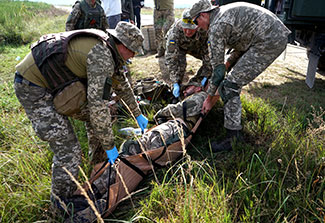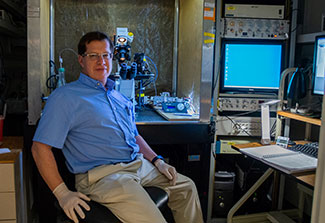Probing the biology of pain during the Ukrainian crisis
September/October 2023 | Volume 22 Number 5
 Photo courtesy U.S. Army National Guard/Amy CarleUkrainian soldiers provide medical response in a simulated casualty situation in 2018.
Photo courtesy U.S. Army National Guard/Amy CarleUkrainian soldiers provide medical response in a simulated casualty situation in 2018.
By Susan Scutti
About two decades ago, scientists shifted their focus from pain as a symptom of underlying illness to chronic pain as a disease in itself. This led to exploring new therapeutic approaches. Unfortunately, today’s pain medications are neither precise nor side effect-free. “We need to better understand pain mechanisms—the biology of pain—to come up with better drugs,” says Dr. Yuriy Usachev, a professor of neuroscience and pharmacology at University of Iowa who runs a collaborative project between the university and Ukrainian partners studying the role of the body’s complement system in chronic pain. His five-year project, funded by the National Institute of Neurological Disorders and Stroke (NINDS) with support from Fogarty, began in June 2019.
His team aims to identify new drug targets by defining the role played by the complement system in the biology of chronic pain. The complement system, the immune system’s frontline of defense, cleans up damaged cells, helps the body heal after an infection or injury, and assists in destroying microscopic infectious organisms. The system’s name indicates its “complementary” nature in enhancing the work of the body’s infection-fighting cells.
Research findings
It’s well known that the immune system is a contributor to inflammatory and neuropathic pain, which can be caused by various diseases or injuries. Growing evidence now indicates the complement system is “almost inevitably involved in most pain conditions,” says Usachev. Using mouse models, Usachev’s team has verified that the complement system is a critical modulator and regulator of neuropathic pain. They also discovered that the site of action for the complement system in neuropathic pain is the spinal cord.
“The therapeutic implication is that any new drug will need to have good blood brain barrier permeability,” says Usachev. “Another important finding is that, among the multiple cell types in the spinal cord, microglia is the key one.” The project has also shown neurons to be involved, most likely indirectly. Going forward, Usachev’s team will focus on understanding how connectivity from complement system to microglia to neurons works.
 Photo courtesy of Yuriy Usachev
Dr. Yuriy Usachev of the University of Iowa is principal investigator of the NINDS-funded Role of the Complement System in Spinal Mechanisms of Chronic Pain.
Photo courtesy of Yuriy Usachev
Dr. Yuriy Usachev of the University of Iowa is principal investigator of the NINDS-funded Role of the Complement System in Spinal Mechanisms of Chronic Pain.
A perilous period
A timeline of Usachev’s project tells a tale of the worst possible circumstances to conduct research in Ukraine, the Eastern European nation sharing borders with Russia, Belarus, Hungary, Slovakia, Romania, Moldova, and Poland. On March 11, 2020, WHO declared COVID-19 a pandemic (that did not officially end until May 5, 2023). In February 2022, Russia invaded Ukraine and continues its offensive to this day.
Usachev believes studying chronic pain in Ukraine is crucial. Persistent pain affects 100 million Americans and 15 million Ukrainians. “I can only imagine this [Russian invasion] resulted in more people harmed—so chronic pain will be a critical and major public health issue,” he says. His Ukrainian partners include Bogomoletz Institute of Physiology in Kyiv. A center of excellence that brings together experts and fosters innovation in neurobiology and electrophysiology, the institute has made some world-class discoveries, including identifying some of the main ion channels associated with pain. “They learn from us, we learn from them, the benefits are mutual,” says Usachev, who trained at Bogomoletz Institute before moving to the U.S.
Dr. Pavel Belan, an investigator on the project and a biophysicist at Bogomoletz, says this project is the first of its kind for the institute, which is part of the National Academy of Sciences of Ukraine (NASU). The internationally recognized and reputable institute has a strong history of pain research and established relationships with various institutions within the field of pain treatment research. “Our collateral projects are related to the development of new treatments for nerve regeneration and neuropathic pain. We hope that our research will allow the use of these approaches to treat people who have received soft traumas during the war.”
Belan, who also teaches at Kyiv Academic University, says parts of Ukraine, including the central region where Kyiv is located, are not as affected by ongoing conflict as the eastern region. “We have a good anti-missile system in Kyiv, thanks to the U.S. and other nations,” says Belan. Still, those living in Kyiv experience threats and a single alarm can destroy the results of weeks-long experiments.
Dr. Nana Voitenko, a biophysicist at Kyiv Academic University and Dobrobut Academy Medical School, is responsible for behavioral testing and developing pain models for the project, while also helping to establish a center of excellence in pain research. She says the war forced the team to move to the western Carpathian region for two months. Though they feared Kyiv would soon be occupied, they continued to work, concentrating on data analysis and paper writing. In April 2022, they returned to Ukraine’s capital and resumed their experiments. By October, missile attacks on Kyiv had become frequent, causing blackouts, so they stopped again. “That winter, electricity was provided for only four hours a day,” recalls Voitenko. With laboratory temperatures dropping close to freezing, the health of experimental animals became endangered, and once again the team was forced to suspend their research.
In spring, the blackouts ended and once again the team resumed experiments. “Even now in Kyiv, we have air raids and hear alarms every day, but more often during nighttime,” says Voitenko. Loss of sleep increases each team member’s physical, moral and psychological stress. Several Bogomoletz employees volunteered for the war effort (though scientific employees are not subject to mobilization). “One of our young colleagues, a 33-year old man named Dr. Bizhan Sharopov, died in action. Of course, this has affected our work, but it also made us even stronger in our vision to win and to return to our normal life.”
Pain & PTSD
There’s a very strong interrelationship between post-traumatic stress disorder (PTSD) and pain, notes Usachev. “Pain contributes to PTSD, but PTSD is also a risk factor for developing chronic pain.” He adds one aspect of pain “that is not emphasized enough is that it’s not only physiological, but also psychological.” Emotions can significantly amplify pain and convert it from transient to chronic.
Great numbers of soldiers, veterans, and civilians in Ukraine suffer from the consequences of war, says Voitenko. While the primary motivation for the project is to improve pain management and overall health for Ukrainians, contributing to the global body of knowledge about pain will be another key outcome. She has been invited to become a scientific adviser by the new Minister of Education and Science. “This volunteer position will help us establish a new center for PTSD and neurological disorders,” she says. She, Belan, and other Ukrainian experts have begun working toward this goal.
Belan, dedicated to his country’s scientific achievements, understands the urgency of this moment. With most of Ukraine's budget allocated for defense, he hopes to protect research opportunities since “many young people are very patriotic and would like to stay and work in Ukraine." Facing first a pandemic and then an invasion, members of this team have surmounted innumerable obstacles, he says. "In terms of the number of papers that we have published, the project has been very successful. Our scientists are strong and have a lot to contribute."
More information
Updated October 17, 2023
To view Adobe PDF files,
download current, free accessible plug-ins from Adobe's website.
Related World Regions / Countries
Related Global Health Research Topics